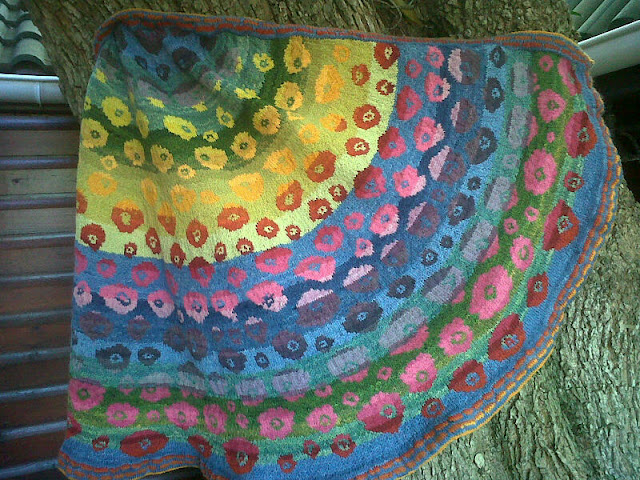Last year I purchased Dorothea Fischer's pattern and the plant dyed yarns for the poppy flower shawl inspired by Kaffe Fassett's pattern but knitted in the round with a steek. (see post 4 July 2012)
Letztes Jahr kaufte ich Dorothea Fischers Muster und das pflanzengefaerbte Garn fuer das Mohnblumentuch, inspiriert von Kaffe Fassets Mohnblumenmuster aber rund gestrickt mit "steek".
However, rather than a trianglular shawl I wanted to knit a half circle and irregular flowers giving the impression of a poppy field as seen in Europe in summer.
Allerdings wollte ich anstelle des Dreiecktuches lieber ein halbkreisfoermiges Tuch stricken und die Blueten sollten ungleichmaessig sein, wie auf einer Blumenwiese im Sommer in Europa.
Six shades of yellow and green were the result of dyeing with reed.
For the three greens iron water was added to the dye pot. (nails left in water in a glas bottle for several days)
I followed Dorothea Fischer's recipe in her book "Naturfarben auf Wolle und Seide" and found that I need a lot less reed blooms than the recipe mentioned (only a bit more than half the amount). I presume that due to our climate - the stronger sun and warmer temperatures - the dye yielded by the plants might be much more effective than in the middle European climate.
Sechs Gelb- und Gruentoene habe ich beim Faerben mit Schilf erzielt. Fuer die Gruentoene wurde dem Farbbad Eisenwasser zugesetzt (Naegel in einem Marmeladenglas mit Wasser bedeckt fuer mehrere Tage).
Ich habe Dorothea Fischers Rezept aus ihrem Buch "Naturfarben auf Wolle und Seide" benutzt und fand, dass ich bedeutend weniger Schilfblueten brauchte als das Rezept angibt (nur etwa die Haelfte). Ich vermute, dass dies an unserem Klima in Sued Afrika liegt; durch die starke Sonne und die hoeheren Temperaturen koennte die Farbeffizienz hoeher sein als im mitteleuropaeischen Klima.
For comparison: the first skein on the left was dyed with onion skins, the second with carrot leaves and the three following skeins with reed blooms.
Zum Vergleich: der erste Strang links wurde mit Zwiebelschalen, der zweite mit Karottenblaettern und die drei naechsten mit Schilf gefaerbt.




